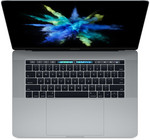Apple MacBook Pro 15 2016 (2.7 GHz, 455)
Specifications

Price comparison
Average of 1 scores (from 1 reviews)
Reviews for the Apple MacBook Pro 15 2016 (2.7 GHz, 455)
The perfect balance? We also review the mainstream configuration of the new MacBook Pro 15. The test model is faster than the entry-level spec thanks to the Core i7-6820HQ and the AMD Radeon Pro 455, but is it worth the additional price?
Source: HDblog.it
 IT→EN Archive.org version
IT→EN Archive.org versionPositive: Excellent display; good cooling system; comfortable touchpad. Negative: Relatively high price; difficult to repair.
Single Review, online available, Long, Date: 03/18/2017
Comment
AMD Radeon Pro 455: Mobile GPU based on Polaris 11 that is found in the more powerful Apple MacBook Pro 15-inch Late 2016. Probably a slimmed-down version of the Radeon RX 460 (clocks and possibly shader count).
Modern games should be playable with these graphics cards at low settings and resolutions. Casual gamers may be happy with these cards.
» Further information can be found in our Comparison of Mobile Graphics Cards and the corresponding Benchmark List.
Intel Core i7: The Intel Core i7 for laptops is based on the LG1156 Core i5/i7 CPU for desktops. The base clock speed of the CPUs is relatively low, but because of a huge Turbo mode, the cores can dynamically overclock to up to 3.2 GHz (920XM). Therefore, the CPU can be as fast as high clocked dual-core CPUs (using single threaded applications) but still offer the advantage of 4 cores. Because of the large TDP of 45 W / 55 W, the CPU is only intended for large laptops.
6820HQ: Skylake-based quad-core processor for notebooks. Offers an integrated HD Graphics 530 GPU and is manufactured in 14 nm.» Further information can be found in our Comparison of Mobile Processsors.
15.40":
15-inch display variants are the standard and are used for more than half of all laptops.
The reason for the popularity of mid-sized displays is that this size is reasonably easy on the eyes, often allows high resolutions and thus offers rich details on the screen, yet does not consume too much power and the devices can still be reasonably compact - simply the standard compromise.
» To find out how fine a display is, see our DPI List.Apple: Apple is a US company founded in 1976 by Steve Jobs, Steve Wozniak and Ronald Wayne. Headquartered in Cupertino, California, the company is known for its innovative products such as the iPhone, iPad, Mac, and Apple Watch, and manufactures computers and consumer electronics as well as operating systems and application software. Apple is also a leading provider of software and services such as the App Store, iTunes and iCloud.
Apple has earned a reputation as a company that focuses on design and ease of use. As for their notebooks, they are mostly in the high-priced segment, have their own operating system, but also run Windows on the newer Macbooks.
Apple is one of the most valuable companies in the world and has a loyal following of customers and fans. The company also has a strong presence in the entertainment industry, with services like Apple Music and Apple TV+. In 2023, Apple had an approximate 8% market share of global PC sales, ranking it 4th after Lenovo, HP, and Dell.
87.9%: This is an above-average rating. Nevertheless, it should not be forgotten that about one fifth of all tested models receive a better rating.
» Further information can be found in our Notebook Purchase Guide.











